If you’ve been reading our blog, then by now you probably know that Argentine asado is taken very seriously. It is more than just sustenance— it’s a huge part of culture, a way of life. But this also extends to other dishes, such as Vitel Toné, which has particular importance in the Argentine Christmas table. Curious to know more? Here I answer every question, from what is Vitel Toné to how to prepare it yourself.
So, where did this very particular dish come from? Well, it’s believed that Vitel Toné has its roots in Italian culinary heritage, particularly in the Piedmont region. Legend has it that Italian immigrants brought the recipe with them to Argentina (as it happened with many other dishes from Argentine cuisine!), where it evolved over time to become a staple of the country’s gastronomy.
Vitel toné is prepared during warm summer days, especially during Christmas, when families and friends gather together for a celebratory meal. What better way to celebrate than with a platter of thinly sliced beef tenderloin smothered in a creamy tuna sauce?
Vitel Toné is a popular dish that you can find throughout Argentina, from the streets of Buenos Aires to the mountainous Patagonia. While it might seem counterintuitive to enjoy a dish like Vitel Toné during the hot summer months, it’s as traditional to eat Vitel Toné during Christmas (despite the heat) as it is to eat turkey during Thanksgiving.
In fact, many people families prefer not to prepare Argentine asado outdoors during the hottest months of the year. In these cases, air-conditioned homes provide a comfortable environment for enjoying dishes like Vitel Toné.
While the dish is very popular in Argentina, it’s not widely available in restaurants, especially out of the holiday season. If you wish to have a taste of Vitel Toné, then you’ll need to prepare it yourself. And I’d like to show you how.
The first step to prepare Vitel Toné is selecting the finest ingredients So, roll up your sleeves, sharpen your knives, and get ready to prepare a dish that is as delicious as it’s exotic.

1 beef tenderloin (about 2 pounds)
2 cans of tuna in oil, drained
1 cup mayonnaise
1/4 cup capers, drained
4 anchovy fillets
1/4 cup white wine vinegar
1/4 cup olive oil
Salt and pepper, to taste
Hard-boiled eggs and additional capers for garnish
The star of this show is undoubtedly the sauce, which is as delicious as it’s easy to prepare. You’ll need a processor or blender to meld together the drained tuna, mayonnaise, anchovy fillets, white wine vinegar, and olive oil.
Blend the ingredients until they are well combined and the texture is smooth. This process usually takes around 1 to 2 minutes, but the exact time may vary depending on the power of your appliance and your desired consistency. Aim for a creamy texture with no large chunks remaining!
Assembling your Vitel Toné is a piece of cake. First, pour the tuna sauce over the sliced beef tenderloin, ensuring it’s evenly coated. Then, garnish the dish with additional capers and sliced hard-boiled eggs for a traditional touch.
The best (and hardest) part is coming: cover the assembled Vitel Toné with plastic wrap and refrigerate for at least 2 hours, or until well chilled. Accompanied it with crusty bread or a simple salad. ¡Buen provecho!
The traditional Vitel Toné recipe includes many ingredients, but feel free to customize it to suit your preferences. For example, if you prefer to skip the tuna, you can substitute it with cooked chicken breast or even silken tofu for a vegetarian version.
While beef tenderloin is the classic choice for Vitel Toné, you can certainly experiment with other cuts of meat, such as flank steak. Just be sure to choose a cut without a lot of fat and to adjust cooking times and temperatures accordingly based on the cut you choose.
For extra flavor, consider marinating the beef tenderloin before cooking. A simple marinade (such as my signature salmuera) can infuse the meat with flavor and help to tenderize it. Marinate the meat for at least a few hours, or preferably overnight, before cooking.
To ensure that each bite of Vitel Toné is tender, be sure to slice the cooked beef tenderloin thinly against the grain. You’ll thank me later! These thin slices will ensure each bite is easy to chew and enjoy.
Next time you’re in the mood for Argentine food, consider making a batch of Vitel Toné and discover new, exotic flavors!
Are you looking forward to your weekly asado but find yourself not knowing which sauce to use for your choripan or your t-bone steak? Enter the classic chimichurri, the most well-known Argentine sauce and the perfect companion to grilled meats.
Made with fresh parsley, garlic, oregano, and a hint of chili pepper, chimichurri can be the perfect complement to your Argentine asado. And if you’re not sure how to prepare it, here’s a step-by-step guide to prepare the classic chimichurri recipe – the best you’ve ever tasted. Shall we?
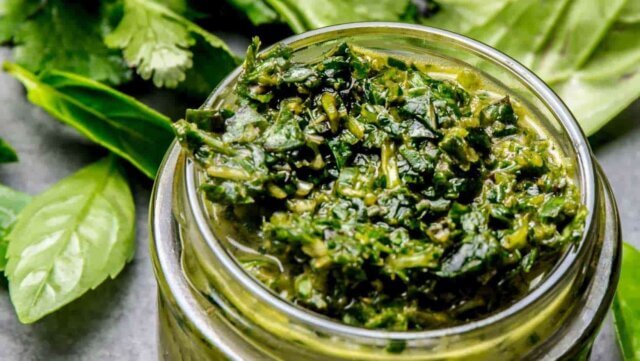
Where does the eccentric name “chimichurri” come from? Its exact origins are somewhat debated, but it’s widely believed to have originated in Argentina, particularly among the gauchos who roamed the Argentine pampas during the 19th century.
Regarding its name, some people propose that it’s derived from the Basque word “tximitxurri,” meaning “a mixture of several things in no particular order,” which aptly describes the way this sauce is made.
Today, chimichurri’s popularity has spread far beyond the borders of Argentina and Uruguay, gaining recognition as a versatile condiment that pairs excellently with grilled meats, including beef, pork, chicken chorizo, and Patagonian lamb.
1 cup fresh parsley, finely chopped
4 cloves garlic, minced
1/4 cup white vinegar
1/2 cup extra-virgin olive oil
1 tablespoon dried oregano
1 teaspoon red pepper flakes (adjust to taste)
Salt and pepper to taste
Start by finely chopping the fresh parsley and mincing the garlic cloves, then put them into the same bowl. Even though it may be tempting to save time, avoid using dried parsley or garlic powder, as they won’t have the same taste.
Then, pour the white vinegar over the parsley and garlic mixture; its acidity will help balance the flavours and give the sauce its signature tang.
If it’s your first time tasting chimichurri, perhaps you’d like to make it with milder acidity and a slightly sweeter undertone. In that case, you can use apple cider vinegar. Others prefer to prepare this sauce with red wine vinegar, which makes it stronger.
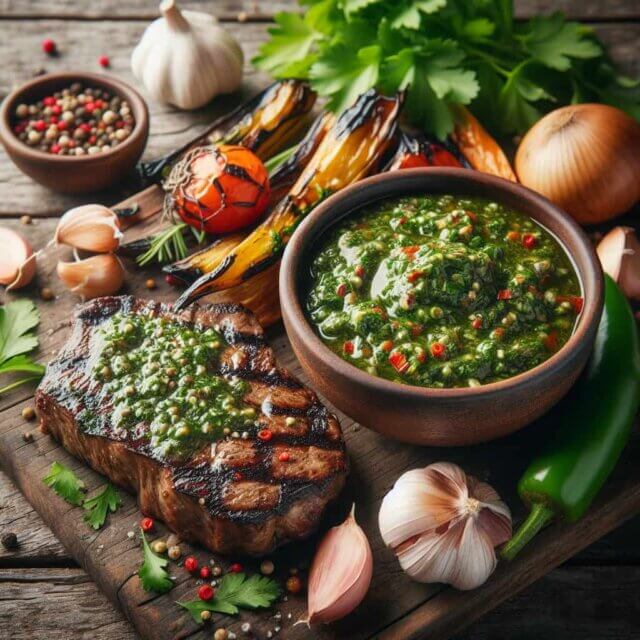
Now, slowly drizzle the extra-virgin olive oil into the bowl, whisking continuously to emulsify the ingredients. You may find that some recipes opt for a blend of oils instead of just extra-virgin olive oil.
For example, sunflower oil is very popular in Argentine cuisine, with its neutral taste and high smoke point. When it comes to chimichurri, it can add a lighter texture and ensure the sauce maintains its green color.
Sprinkle the dried oregano and red pepper flakes (ají molido) over the mixture, then season with salt and pepper to taste while using a spoon or whisk to mix all the ingredients together.
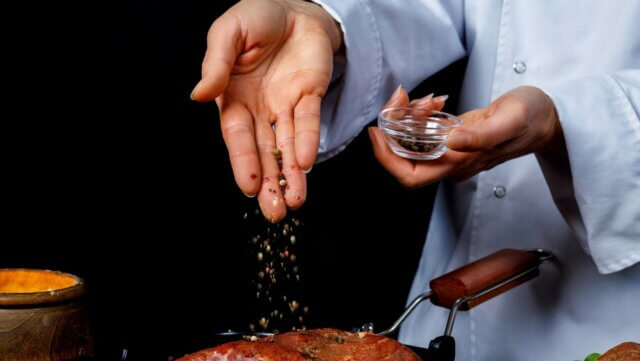
If you’re looking to experiment, some spices can make your chimichurri a bit more unique:
It’s time to taste your chimichurri and fine-tune it to your taste. So, grab a spoon, put a bit of the sauce on a piece of bread and taste it!
Perhaps you find that the chimichurri could benefit from a touch more acidity, so you can add more vinegar. Or maybe you realize you put too much ají molido, which you can solve by adding more oil.
Time for the grand finale: cover the sauce and let it sit at room temperature for at least 30 minutes (don’t be tempted into using it right away!). Freshly prepared chimichurri can sometimes have sharp, intense flavors, particularly from the raw garlic and vinegar, that won’t be tasty.
Instead, allowing your chimichurri sauce to rest will significantly enhance its texture while balancing its taste. Some experts even suggest preparing chimichurri a few days in advance or even weeks before you plan to use it to maximize its development.
And that’s it. Chimichurri is a versatile sauce, suitable to complement not only grilled meats but also seafood. So, the next time you find yourself in Argentina, be sure to keep an eye out for freshly prepared chimichurri and explore what this iconic condiment has to offer.
Or maybe you’d like to experiment at home and expand your Argentine grilling repertoire with this step-by-step chimichurri recipe. Enjoy!
If you are a meat lover, you probably have heard of the Argentine asado, or barbecue. But do you know what makes it so special and mouth-watering? It’s not just the quality of the meat, which is usually grass-fed and organic. It’s not just the variety of the meat, which includes everything from beef to lamb to sausages to offal. It’s not even just the sauces, which are fresh and tangy and add a burst of flavor to every bite. No, what makes the Argentine asado truly amazing is the way it is cooked: over a wood fire, using different techniques that have been perfected over generations. In this article, we will take you on a journey through some of the most common and delicious Argentine outdoor grilling techniques that will make you want to book a flight to Buenos Aires right now.
The first thing you need to know is that in Argentina, grilling is not done over charcoal or gas. That would be sacrilege. Grilling is done over wood, which gives the meat a unique smoky taste and aroma that you can’t get from any other fuel. The type of wood used depends on the region and the preference of the cook, but some of the most popular ones are piquillin (a hard and dense wood that burns for a long time), algarrobo (a sweet and fragrant wood that adds a subtle flavor), and espinillo (a thorny and aromatic wood that creates a lot of smoke). The wood is burned separately in a fire pit or a brasero (a metal basket) until it produces hot coals, which are then spread under the grill.
The grill itself is called a parrilla, and it can have different shapes and sizes depending on what you want to cook and how you want to cook it. The most common parrilla is a flat metal grate with rods or bars that can be raised or lowered by a wheel or a crank to adjust the distance from the coals. This allows you to control the heat and the cooking time with precision. You can use this parrilla to cook almost any cut of meat, from steaks to ribs to sausages. Another type of parrilla is the cruz, which consists of two metal crosses that hold the meat vertically over the fire. This technique is usually used for large cuts of meat, such as whole lambs or pigs, that need to be cooked slowly and evenly. The cruz gives the meat a crispy exterior and a tender interior, and it looks impressive as hell. A third type of parrilla is the disco, which is a large metal disc or wok that is placed over the coals and used to cook stews, soups, or vegetables. The disco is great for making dishes that have a lot of liquid and flavor, such as locro (a hearty corn and meat stew) or humita (a creamy corn pudding).
The meat that is grilled on the parrilla is usually seasoned with only salt and sometimes pepper, garlic, or herbs. The reason for this is simple: the meat is so good that it doesn’t need anything else. The salt enhances the natural flavor of the meat, while the pepper, garlic, or herbs add some extra kick. The most popular cuts of beef are vacío (flank steak), entraña (skirt steak), asado de tira (short ribs), bife de chorizo (sirloin steak), bife de lomo (tenderloin steak), and matambre (flank steak stuffed with cheese, ham, eggs, and vegetables). Other types of meat that are commonly grilled are pork, chicken, lamb, goat, sausages, blood sausages, kidneys, sweetbreads, and chitterlings. If you are feeling adventurous, you can try some of these delicacies that are considered delicacies in Argentina.

The parrilla is the most common grilling method in Argentina, and it closely resembles what most people think of when they hear the term “barbecue.” It involves cooking meat over a charcoal or wood fire on a grill rack, typically accompanied by the use of a parrilla (grill grate) that can be adjusted in height. The most popular cuts of meat used in parrilla grilling include ribs, sausages, flank steaks, and ribs. The slow, indirect heat creates tender, smoky, and flavorful meat that’s often seasoned simply with salt.
This is the most classic and traditional tool, it consists of a metal grate with bars that you can raise or lower to adjust the heat. You can use this grill to cook almost any cut of meat, from steaks to ribs to sausages. This tool became popular when workers used it to make their barbecues on construction sites, which is why it’s called “work barbecue”. It sounds like hard work, but it’s worth it.
To use this grill properly, you have to prepare the fire separately so that when the coals are ready, you can spread them evenly under the grill. You have to let the iron get hot and remove any fat that has stuck to it.
Then you place the meat on the grill and watch as magic happens. The salt and fat fall on the coals and create smoke and flames that give the meat a crusty and tasty surface. The meat also releases its juices, which you can soak up with bread or drink directly from the grill. Don’t judge us.
/cloudfront-us-east-1.images.arcpublishing.com/artear/M5L5HUZBHVD2RMERS4A67PQL4Q.jpg)
This is one of the most impressive and badass tools, it consists of an iron frame that has the shape of a cross that you hang the meat on. You place it over the coals and let it cook slowly and evenly. Down in the southern reaches of Argentina, this technique is a big deal, especially when it comes to cooking the famous “roast with leather.” No, they aren’t making a fashion statement; they’re talking about leaving the animal’s skin on to prevent it from drying out. It’s like eating leather jackets, but in a good way – the kind of fashion-forward cuisine that even Milan would approve of.
This contraption consists of an iron frame, and it’s not just any frame; it has the shape of a cross. Yep, you heard it right, you hang the meat on a cross. It’s like turning your barbecue into a high-stakes culinary exorcism. You place this meat crucifix over the coals and let it cook slowly and evenly, just like a BBQ guardian angel watching over your feast.

The “Chapa,” also known as the metal griddle, is like the superhero of the Argentine grilling world, swooping in to save the day when you’ve got a craving for thinly sliced meats and grilled veggies. It’s the kitchen tool that goes sizzling where no grill rack has gone before.
It’s a method used for preparing thinner cuts of meat and other ingredients like vegetables. This technique involves cooking directly on a hot metal surface, often with a small amount of oil or fat to prevent sticking. Thin steaks, sausages, and provoleta (melted provolone cheese) are commonly prepared on the chapa. It results in quick and even cooking, ideal for those who prefer their meat well-done or just in a hurry to get their grilling fix.
The chapa technique is all about simplicity and speed. You don’t need fancy grill marks or smoky complexities here. Just lay your thin steaks, sausages, or a slab of provoleta (melted provolone cheese) on this blazing-hot griddle. Add a dash of oil or fat, and you’re good to go. It’s like a well-lubricated slip ‘n slide for your ingredients.
One of the beauties of chapa grilling is its quick and even cooking. It’s the go-to method for those who prefer their meat well done or simply can’t wait to satisfy their grilling cravings. So, if you’re the kind of person who checks their watch impatiently while the coals heat up, chapa grilling is your salvation. No more drumming your fingers while waiting for the grill to reach the perfect temperature; the chapa is always ready for action.
And let’s not forget about the versatility of the plancha or better said “chapa”. It’s not just a meat maestro; it’s an all-in-one performer. You can throw your veggies, cheese, or anything else that tickles your taste buds right onto the sizzling surface. It’s like a one-stop shop for your grilling desires, where the only limit is your imagination.
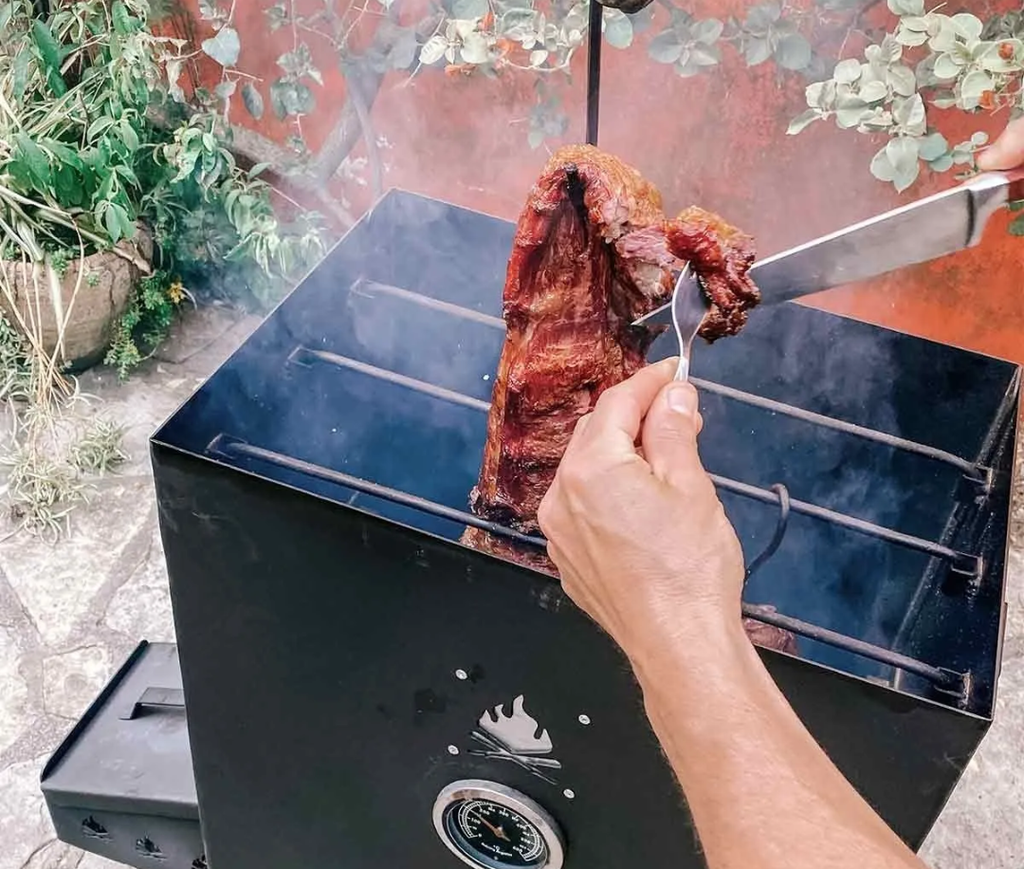
The process is as delightful as it is straightforward. Instead of tossing the wood into the fire, the Argentine grill master places it strategically beside the grill. As the wood smolders, it releases a gentle plume of fragrant smoke that mingles with the sizzling meat. It’s like the meat is enjoying a rejuvenating spa day, except the hot stones are replaced with smoldering wood, and the aromatherapy is courtesy of the enchanted forest.
This smoky infusion adds a layer of depth and complexity to your grilled delicacies, elevating them from everyday eats to culinary masterpieces. It’s the secret ingredient that makes your barbecue dishes memorable, and it’s almost as if your grill suddenly earned a Michelin star.
So next time you’re in Argentina or hosting a barbecue, consider these diverse techniques to take your grilling game to the next level and savor the essence of Argentine cuisine while sharing a laugh or two with friends and family.
If you like our grilling blog and follow me on YouTube, you probably think you know a thing or two about authentic Argentine asado. After all, it’s an emblem of the world’s gastronomy, the ritual that brings family and friends together every Sunday, and the ultimate test of food passion. But do you know the secrets of a perfect barbecue, or are you just winging it with the fire and the meat? Don’t worry, I’m here to help you. I’m going to share with you 10 tips that will make you the grill master and earn you the applause of your guests. So put on your apron, grab your tongs, and get ready to grill!

Select your cuts with the precision of a casting director looking for a leading role. Go for a ribeye with more marbling than a soap opera or some ribs that could star in their cooking drama. Always add Beef Ribs! In Argentine asados ribs are a must, they are amazing.
Choose your meat wisely. This is the first and most crucial step for a great asado. You should select high-quality, fresh cuts of meat with the right thickness. The most popular cuts include flank steak, ribeye, skirt steak, sirloin, and tenderloin. You can also include offal such as blood sausage, chorizo, sweetbreads, and thick intestine. Don’t be fooled by supermarket deals or labels that say “premium” or “select.” It’s best to visit a trusted butcher who can provide advice and cut the meat to your preference.
The top tip here is to look for freshness in the meat and understand the supply chain so you can make an informed decision about what meat you would like to put on your Argentine grill! That being said, its wise to choose meat that is bright red, and “glossy” instead of darker and opaque.
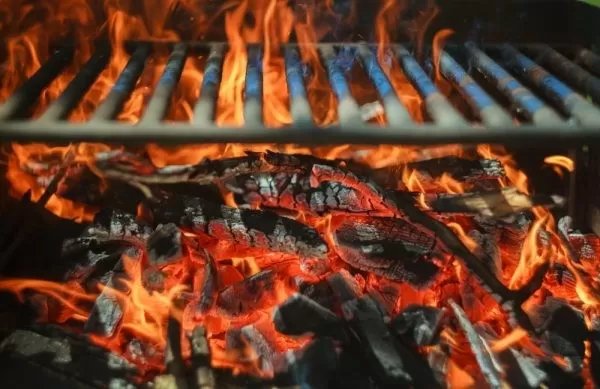
Fire it up, baby! A true “asador argentino” can’t mess around with a feeble fire; you need to set the stage with some flaming charisma. Fire is the soul of the barbecue and should be ready before you start cooking. Ideally, use dry wood, which imparts a special aroma and flavor to the meat. If you’re using charcoal, ensure it’s of good quality and well-lit. The fire should be moderate and consistent, and you should have enough to sustain it throughout the barbecue. Avoid using paper, alcohol, or other accelerants to ignite the fire, as they can contaminate the meat and cause accidents. It’s best to use a bit of thin wood, some dry leaves, or pinecones and patiently blow on them until the fire catches. And if you have a blower or a set of bellows, even better!
In the delightful world of Argentinian asados, the grill master must have every necessary gadget at their fingertips. You don’t want to be caught off guard and ruin the meat like a true amateur! So, first things first, those long, graceful tongs are your best friend. They’re not just for show; they’re your trusty tools for flipping the meat without poking holes in it – a cardinal sin in the asado world!
Now, here’s where things get spicy – literally! You’ll need a pair of gloves, not because the grill is cold and needs warming up, but to safely handle those hot grates. We wouldn’t want you to end up with grill marks on your fingertips, would we?
But wait, there’s more! In the unpredictable world of asados, sometimes flames decide to do their own tango. For that, you must have a trusty spray bottle within arm’s reach. It’s not just for extinguishing rogue flames; it’s also a handy tool for giving your guests a refreshing mist. Who needs a fancy spa when you’ve got an asado?
Season the meat with coarse salt. Salt is the only superstar in the flavor department here – it’s like the Beyoncé of seasonings. Just sprinkle that salty diva right before you toss the meat on the grill, using the chunky stuff, and make sure it’s evenly distributed. No need to invite the fine salt or any other flavor wannabes to the party; they’ll just get burnt and crash the flavor extravaganza. And don’t go overboard with the salt – we’re aiming for meat flavor, not a mouth-puckering dried-up sea monster. The golden rule is a tablespoon of salt per kilo of meat. If you’re feeling fancy, you can also throw in some sprigs of rosemary or thyme for that extra flavor pizzazz – they’ll add a delightful aroma, like a gourmet red carpet entrance.
Control the grill temperature. The grill should be clean and greased and at the right distance from the flames. To check if the grill is ready, you can place your hand over it and count to five. If you can’t take it anymore, it’s way too hot. If you can tough it out, it’s way too cold. The sweet spot is when you can count to five without turning your hand into a barbecue mitt. To adjust the temperature, you can raise or lower the grill or play around with the fire. You could also use a grill thermometer for an exact reading, but don’t just trust the numbers; rely on your intuition and experience as well.
You should only throw some of the meat on the grill at a time, you must follow the cooking hierarchy of each cut.
The key to mastering this culinary adventure is to kick things off with the thick cuts, like the vacio or flank steaks, rack of ribs, and that wide strip steak. The vacio starts its sizzling journey skin-side down, while the wide strip steak chooses the bone-side path. Cooking times are a bit like playing the lottery – usually, it’s somewhere in the ballpark of 1 hour to 1 hour and a half, depending on how hefty your meat friends are feeling.
Now, it’s showtime for the chinchulines – the indispensable Argentine barbecue comrades. They waltz onto the grill almost simultaneously with our earlier meaty stars and strut their stuff for about 50 minutes until they are ready.
In the next act, you introduce the sweetbreads and those daintier cuts like tenderloin, the tail of rump, and the regular strip steak. After 15 minutes, you throw in the sausages, and in about 30 to 40 minutes, they’ll be in perfect harmony.
Lastly, it’s time to give a warm welcome to the blood sausages, the “morcillas.” They’re low-maintenance, they just need a little heating up. After 15 minutes on the stage, your culinary ensemble is ready to steal the show, complete with sausages and offal. Voilà, the grand unveiling of the ultimate guide to transforming meat into a work of art, Argentine style!
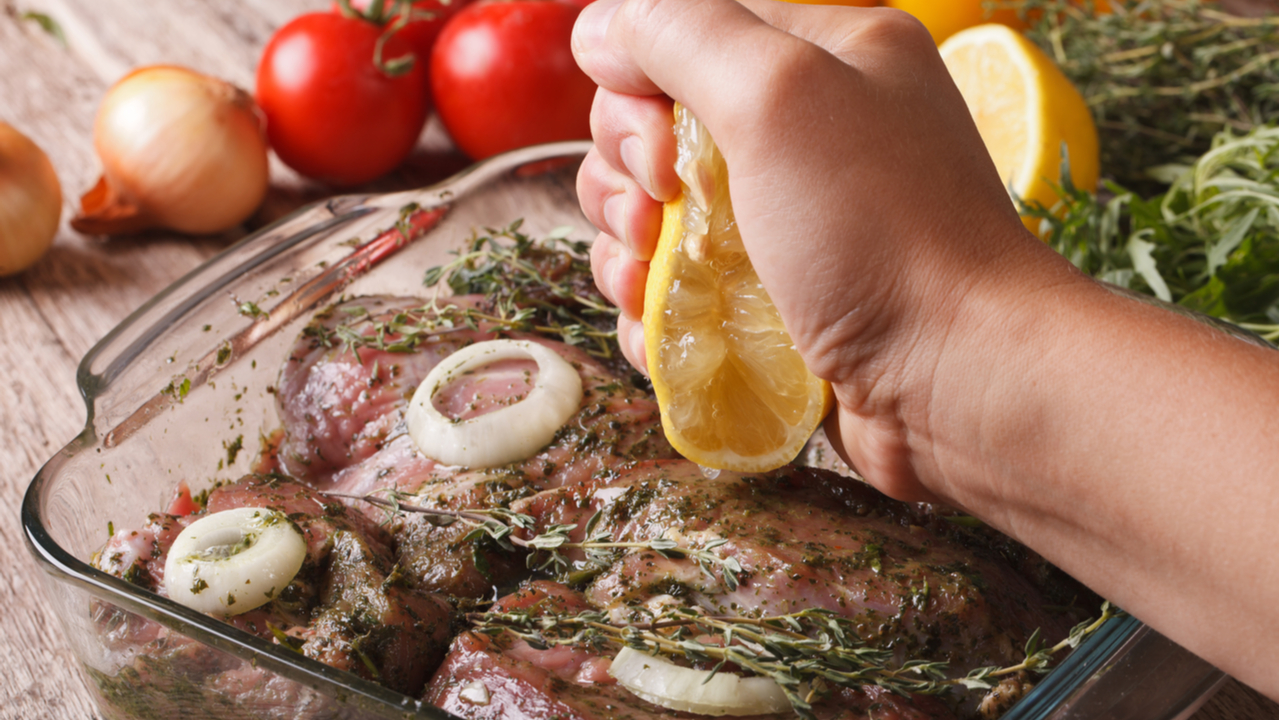
A marinade or salmuera is like the makeup for your meat. It’s the secret sauce that turns a humble cut into a superstar of the grill. But what is the best marinade for asado, the traditional Argentine barbecue? To make it shine, you need a simple but flavorful marinade that enhances its natural taste and texture. Here are the ingredients you need to make your own magical marinade for asado:
To make your marinade, mix all the ingredients in a large bowl. Then, take your meat and rub it generously with the marinade, making sure to cover every inch. Place the meat in a large ziplock bag or a glass container and refrigerate it for at least four hours, or overnight for better results. The longer you marinate, the more flavor your meat will have.
In an Argentinian asado, there’s a sacred rule: “Thou shalt not poke the meat!” Seriously, it’s almost a sin to stab or slice that juicy meat just to check if it’s done. It’s like sending the flavorful juices on an unscheduled vacation 😂 ! The tiniest cut can turn your meat into a Sahara Desert mirage. And oh, let’s not forget that those runaway juices can cause a fiery spectacle, turning your grill into a flamethrower, and you into a BBQ firefighter. So, instead of playing ‘Whack-a-Mole’ with your meat, always have a trusty spatula by your side to flip it like a pro. Your taste buds will thank you, and your asado will be the stuff of legends!
Now, picture this. Your parrilla, that sizzling stage where the magic happens, needs its own little act – the cover. This piece of grill theatre is like the conductor of a symphony, ensuring the heat dances all over the grill, serenading your meats to perfection.
But, here’s the kicker: if you leave the cover open, it’s like inviting the heat to a party it can’t attend. And what does that mean? Yep, you guessed it – longer cooking times. The large cuts of meat will be sitting there, wondering when the show’s going to start.
Oh, and let’s not forget about the notorious grill flares we discussed earlier. They are like the uninvited guests who crash your barbecue bash. Closing the lid is like handing them a polite “Sorry, you’re not on the guest list.”
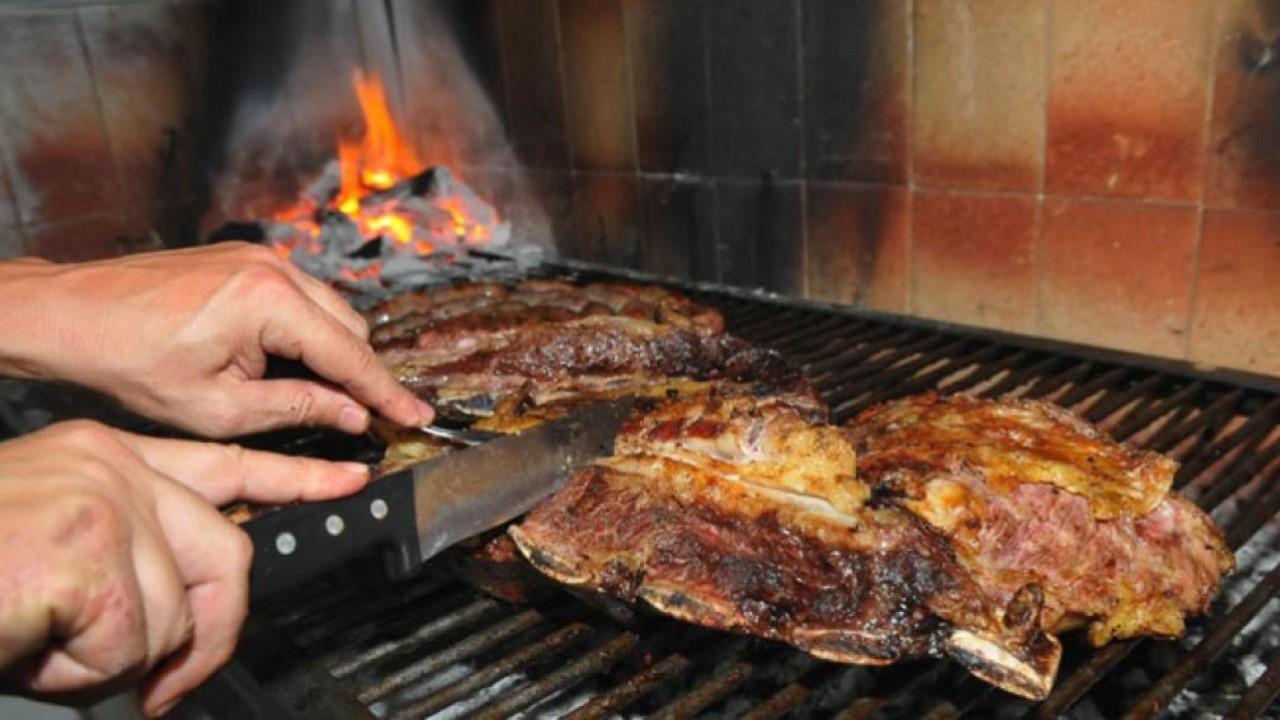
You don’t rush an asado, my friend. It’s not a sprint; it’s a slow and glorious marathon of carnivorous delight. From the moment you spark up that fire, until you finally grace the table with your masterpiece, you’re looking at about three hours, more or less.
Now, this is no sport for the impatient souls. It’s like waiting for that mate who’s always fashionably late to the barbecue, but in this case, we’re all in it together. So, instead of watching the clock, embrace the waiting game with a wry smile. Trust me, the anticipation only makes the meat taste even better. Besides, as they say, good things come to those who wait… especially when they involve sizzling meat, a little fire, and a whole lot of camaraderie.
To ensure the Argentine asado experience is truly outstanding, the slices of meat must arrive at the cutting board intact, and without cooling down too much. They should rest for a few moments to facilitate the redistribution of juices and prevent them from bleeding out prematurely at the first cut before they make it to the plates. This step not only ensures the juiciest and most flavorful results but also adds an extra layer of anticipation and excitement to the whole Asado gathering. So, let those succulent meat cuts settle for a while before you dive in!
Asado is more than just a barbecue in Argentina. It is a social and cultural event that brings together friends and family around a fire, where meat is cooked slowly and expertly over coals, often from a hard-wood fire. Asado is also a way of honoring the legacy of the gauchos, the nomadic horsemen and cattle herders who roamed the pampas of Argentina in the 19th century.
Asado, it’s practically in our national DNA. Well, maybe not literally, but it’s been embedded in our culture since the days of the first colonies. It’s a result of some rather explainable yet undeniably peculiar global phenomena with Argentine Asados in many restaurants across the US and Europe.
Because we’ve got cows and plenty of open fields and because it’s delicious.
It’s that simple.
The word asado means roasted in Spanish, and it refers to both the meal and the gathering. The technique of cooking meat over an open fire was introduced by the Spanish colonizers who arrived in Argentina in the 16th century. They brought cattle from Europe, which adapted well to the fertile and vast plains of the Pampas region.
Back in 1590, the Spaniards brought 500 cows to the shores of the Rio de la Plata. This humble herd, along with some surviving cattle from previous expeditions (left to fend for themselves and run wild), found a chance to thrive in the lush pastures of the humid pampas. In this fertile ecosystem, the cow had no greater predator than humans themselves, so they multiplied like… well, cows.

The history of Argentine asado traces its roots to the gauchos, the legendary cowboys of the Pampas region. In the early 18th century, these skilled cattle herders developed a unique method of cooking meat over open flames, giving birth to the tradition we know today. They seasoned the meat with little more than salt and fire, relying on simplicity to highlight the natural flavors of the beef, which was, and still is, of exceptional quality in Argentina.
The gauchos became legendary figures in Argentine history and culture, similar to the cowboys in North America. They developed a strong sense of identity and pride in their lifestyle, which was influenced by their Spanish, native, and African roots. They also created a rich folklore of music, poetry, and dance, such as the tango. The Asado was an integral part of their culture, as it was a way to share food, stories, and camaraderie with their fellow gauchos.
They used what were readily available resources: firewood and meat. Their seasoning was minimal, primarily salt, and perhaps a sprinkle of chimichurri, allowing the natural flavors of the meat to shine. This simplicity became the hallmark of Argentine asado.
The wood they used was quebracho, a hard and dense tree that produces long-lasting coals. They also used their lassos as makeshift grills, hanging the meat over the fire. This was how the asado was born, as a practical and delicious way for the gauchos to cook their meals in the open air.
As Argentina became more urbanized and industrialized in the 19th and 20th centuries, the asado tradition was adapted to the changing times. The cattle industry boomed, making beef a staple of Argentine cuisine and economy. The asado became a popular way to celebrate national holidays, such as Independence Day and May Revolution Day, as well as family occasions, such as birthdays and weddings. The Asado also became more diverse, incorporating different types of meat, such as pork, chicken, chorizo, and morcilla (blood sausage), as well as vegetables and cheese.
The asador also became more sophisticated, using different cuts of beef, such as ribeye, sirloin, and flank steak, and different methods of grilling, such as direct and indirect heat. The asador also mastered timing and temperature, knowing when to turn each piece of meat for optimal juiciness and flavor. The asador also seasoned the meat with only salt, letting the natural taste of the meat shine through.
The parilla, or grill rack, also evolved. It can be made of various materials, such as metal, wood, or stone, and it can be placed on different structures, such as fireplaces, pits, or drums. The parilla can also be adjusted in height and angle to control the heat intensity. The most important factor is the use of hardwood coals from the quebracho tree, which gives the meat a distinctive smoky aroma.

Today, asado is a weekly ritual for many Argentine families. It is usually held on Sundays when people have more time to enjoy the slow-cooking process and the company of their loved ones. The Asado is also a way to express hospitality and friendship, as everyone is invited to join the feast. It is not only about food but also about conversation, music, and laughter.
The asado starts with lighting the fire and preparing the coals. The asador is usually a man who has learned the art of grilling from his father or grandfather. He is in charge of everything related to the meat: choosing it, cutting it, salting it, and cooking it. He is also responsible for serving it to the guests in stages: first the achuras (offal), then the provoleta (grilled cheese), then the main course of various cuts of beef. The guests show their appreciation by applauding the asador or chanting “un aplauso para el asador” (applause for the grill master).
The guests also contribute to the asado by bringing salads, bread, wines, and desserts. They also help with setting up the table, serving drinks, and cleaning up afterward. They also engage in lively conversations about politics, sports, culture, and life in general. They also enjoy listening to music or playing games while waiting for the meat to be ready.

The Asado is more than just a meal; it is an experience that reflects the history and culture of Argentina. It is a way to honor the legacy of the gauchos, who created a unique and delicious way of cooking meat over fire. It is also a way to celebrate the diversity and richness of Argentine cuisine, which incorporates influences from various regions and ethnicities. Most importantly, it is a way to enjoy the simple pleasures of life: good food, good wine, and good company.
So, here’s to Argentina, where meat is more than just a meal; it’s a way of life.
So, You’ve got the grill fired up, and the meat is ready to sizzle. But hold your horses; what about the right grilling knives? Don’t fret; we’ve got you covered. In this article, we will review the best Grilling Knives for a true authentic Argentine Asado!
You know that in this game, the knife isn’t just a tool; it’s your trusty sidekick, your culinary companion, and sometimes, your secret weapon. Without the right knife, you’d be butchering the beauty of an Asado, and not in a good way!
Now, before you dash to your local store, or, let’s be real, start scrolling through an endless abyss of online shopping options, there are a few things to consider. It’s not about having a drawer full of knives; it’s about having the right one that makes you feel like a true maestro of the parrilla.

First things first – the blade. It’s a make-or-break choice, much like picking the perfect steak. Do you go serrated or smooth? The serrated edge is like the wild, unruly hair of the knife world, with those jagged teeth, great for sawing through bread but as out of place at an Asado as a penguin in a desert.
What you want is a smooth operator. Why? Because the Asado is all about sliding that blade through your succulent creations. Picture this: slicing into a perfectly grilled steak, gently cutting provoleta, or even gracefully carving a sausage. The smooth edge grants you control, precision, and the art of a perfect cut. Plus, it’s easier to sharpen than its serrated cousin.
Leave the serrated edge for the toast and pineapple; your Asado deserves nothing less than smooth excellence.
Once you’ve decided on the smooth edge, it’s time to find “The One.” A grill knife should feel like an extension of your arm, not some awkward appendage. Here are a few things to consider when hunting for your perfect match:
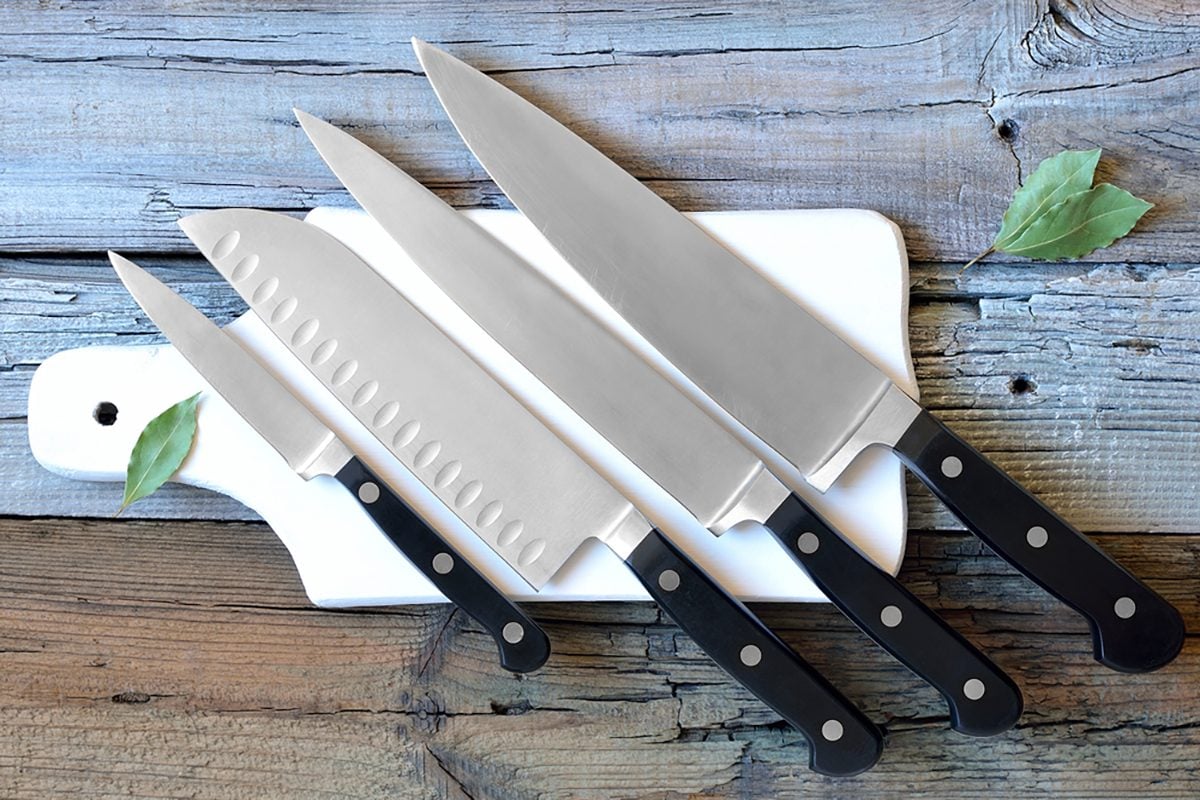
You’ve got the smooth edge, and you’ve met “The One,” but what’s “The One” made of? Knives these days are all about stainless steel, but not all stainless steel is created equal. Here’s a quick rundown:
In the world of artisanal knives in Argentina, there’s a fierce debate that rivals the passion of a Boca Juniors vs. River Plate match. It’s the showdown between carbon steel and stainless steel – the ultimate face-off for choosing the right blade.
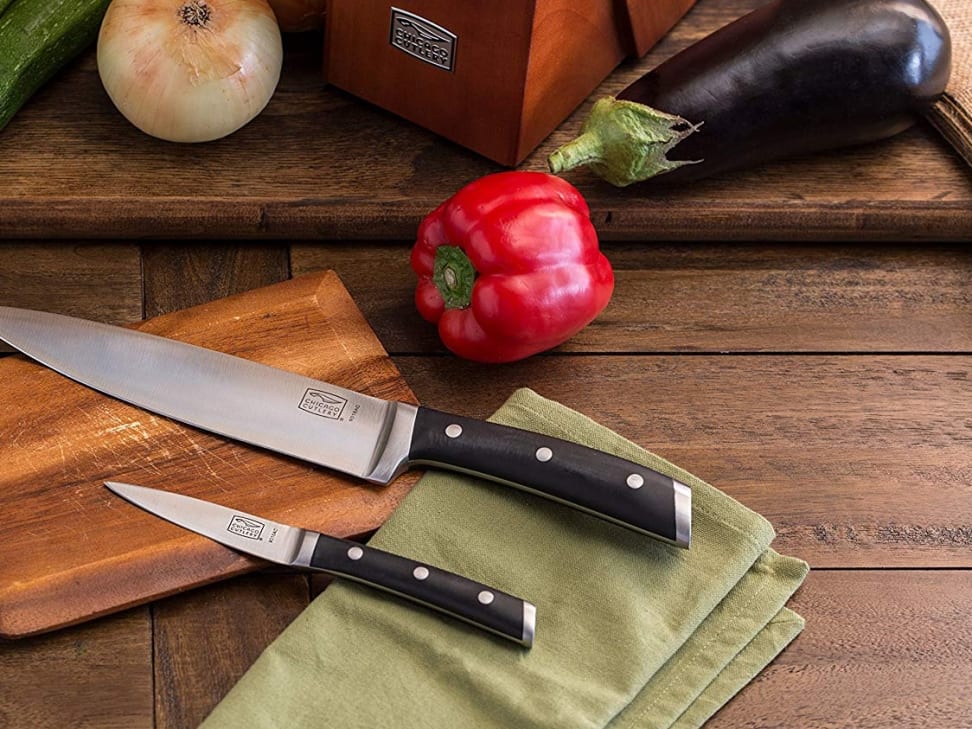
Stainless steel is like that friend who’s always laid-back, never asking for much. It’s known for its resistance to corrosion, making it the ideal choice if you’re the type who throws your knives in the dishwasher and forgets about them. It won’t complain about rust, and it’s less likely to get stained compared to its carbon counterpart. Plus, it’s built to last, enduring the test of time like a seasoned asador mastering the grill.
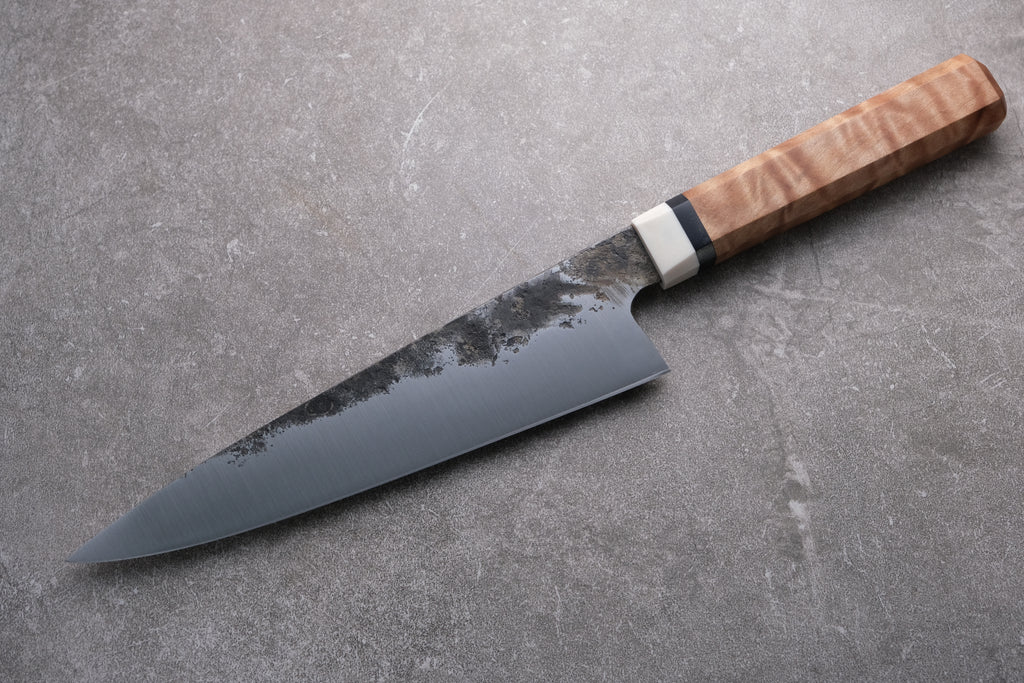
On the other side of the parrilla, we have carbon steel – the maestro of sharpness. It can hold a blade edge like a tango dancer holding a pose. If you seek precision and silky-smooth cuts, this is your go-to steel. But, here’s the twist – it’s a diva. Carbon steel needs a bit of pampering. It’s like that demanding artist who insists on a specific green room temperature. It’s more prone to corrosion, so you’ll have to clean and dry it carefully after every use to avoid that dreaded rust tango.
So, which steel is the true champion for your artisanal Argentine knives? The answer, much like a controversial Maradona vs. Messi debate, depends on your personal preferences and how you’ll use your knives.
If you value low maintenance and corrosion resistance, stainless steel takes the trophy. It’s your partner in crime when you want to focus on the sizzle, not the cleanup.
But if you prioritize a razor-sharp edge that can cut through meat like a hot knife through butter and you’re willing to put in a little extra TLC, then carbon steel is the right match for you.
It’s not just about the steel; it’s about the love and care you put into your craft, whether it’s grilling or choosing the perfect knife. So, pick your steel and start slicing your way to culinary greatness. Just like in football (soccer), there’s no one-size-fits-all answer – it’s about the game you want to play.
Remember, your knife is not just a tool; it’s an extension of your personality and grilling style. Pick the one that suits you best and show off your skills on the parrilla. Buen provecho, and may your Asado be forever sizzling!
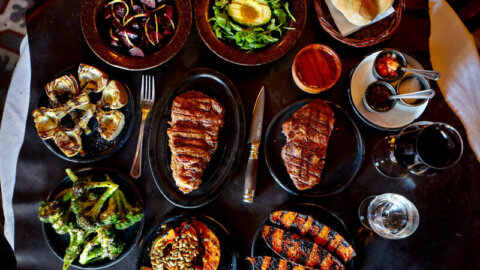
It’s a blessing that you can now enjoy delicious Argentine cuisine outside of Argentina. Thanks to many Argentinians who have immigrated to many parts of the world, they’ve brought their traditions, culture, and of course, the cherished asado, to a global audience.
This is particularly true in the US, where a fantastic array of Argentine culinary delights awaits in every major city. In this article, I’ve crafted a guide to help you find the finest spots for bife de chorizo, vacío, and more. Gear up to discover the nearest location for an unforgettable Argentine Asado experience!
Get ready for a culinary adventure! The list below will guide you from the sizzling asado to the mouthwatering empanadas. Without further ado, let’s explore the best Argentine eateries across the US!
New York City is a melting pot of cultures, and Argentine cuisine adds its own vibrant flavors to this mosaic. From the traditional steakhouses to cozy cafés, the city offers a slice of Argentina for everyone.
513 E 6th St Ground Floor, Nueva York, NY 10009-6621.

Nestled in the heart of the East Village, Buenos Aires Restaurant brings the spirit of its namesake city to New York. With a menu that pays homage to authentic Argentine flavors, this restaurant has become a beacon for those seeking the warmth of South American hospitality.
Signature dishes like the Bife de Chorizo—a succulent, perfectly cooked steak—and customer favorites such as homemade empanadas and milanesas, embody the essence of Argentine culinary tradition. It’s a place where every meal feels like a festive gathering, and the Malbec flows as generously as the conversation.
550 Court St, Brooklyn, NY 11231

For a more casual dining experience, El Mate in Brooklyn offers a cozy glimpse into Argentine comfort food. This establishment radiates a laid-back vibe, making it a cherished spot among both locals and visitors.
The menu features a variety of Argentine favorites, with standout items like the sweet and savory pastries, known as facturas, and the bold Cortado coffee, reminiscent of the lively cafés in Buenos Aires. Patrons often commend the genuine taste and amiable service, suggesting El Mate as a go-to destination for those seeking an authentic Argentine experience in New York.
Miami, a city known for its cultural diversity and vibrant food scene, is also home to some of the finest Argentine cuisine north of the equator. The warmth of the Atlantic breeze complements the fiery grills of Argentine asados found here.

9227 Bird Road Miami, FL 33165
Graziano’s stands as a testament to the rich Argentine heritage, bringing family traditions to the forefront of its culinary experience. The restaurant prides itself on famous dishes that speak to the soul of Argentina, from succulent steaks to flavorful chimichurri.
Guests often rave about the authenticity and quality of their dining experiences, a sentiment reflected in the high ratings Graziano’s consistently receives.
260 Crandon Blvd, Key Biscayne, FL 33149

Patagonia Nahuen serves as a culinary gateway to the heart of Argentine cuisine, offering a menu brimming with traditional flavors and an ambiance that transports diners straight to the bustling streets of Buenos Aires.
Customer reviews frequently praise the varied menu offerings, from the classic empanadas to the rich dulce de leche desserts, highlighting the restaurant’s ability to capture the essence of Argentine dining culture.
In the bustling capital of the United States, Washington D.C., Argentine cuisine offers a gastronomic respite from the fast-paced political environment. Here, diplomatic finesse is matched with the robust flavors of Argentina, providing an international dining experience.
1633 17th St NW #2433, Washington, DC 20009

Malbec Restaurant brings the rich tapestry of Argentine culinary tradition to the heart of D.C., offering a taste of South America amidst the city’s iconic landmarks. The restaurant has become a favorite for its array of popular dishes, such as the tender and flavorful asado and the perfectly grilled choripán.
Patrons often leave glowing reviews, commending the authenticity of the flavors and the attentiveness of the service, cementing Malbec Restaurant’s status as a D.C. dining staple.
777 I St NW, Washington, DC 20001

Del Campo presents a unique twist on Argentine cuisine, blending traditional flavors with innovative culinary techniques. The restaurant has earned acclaim for its creative fusion, with dishes like smoked meats and inventive side dishes capturing the essence of Argentine barbeque with a modern twist.
Customer experiences often emphasize the vibrant atmosphere and the standout signature dishes, making Del Campo a must-visit for those seeking an Argentine culinary adventure in Washington D.C.
Los Angeles, a city celebrated for its diverse culinary landscape and fusion cuisines, also prides itself on its authentic Argentine eateries. Nestled between the sun-drenched beaches and the bustling cityscape, these restaurants offer a slice of Argentine life to Angelenos and visitors alike.
7229 Melrose Ave, Los Angeles, CA 90046

Lala’s Argentine Grill is a gem that brings the heart of Argentina to Los Angeles, offering a warm ambiance reminiscent of a traditional Buenos Aires bistro. The restaurant has deep Argentine roots, reflected in both its vibrant atmosphere and its menu. Customer favorites include the rich and juicy steaks, the traditional chimichurri, and the freshly baked empanadas. Reviews often highlight not just the food but the feeling of genuine Argentine hospitality that Lala’s provides.
7963 Melrose Ave, Los Angeles, CA 90046
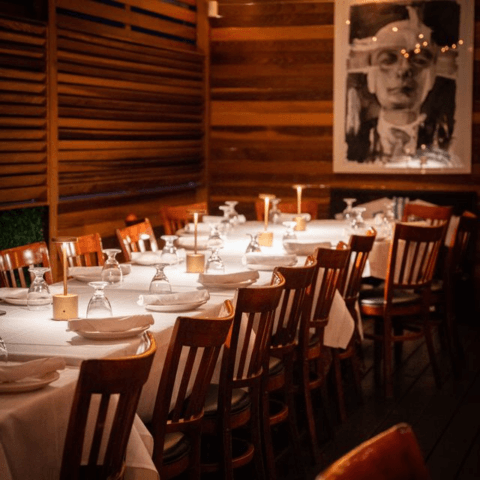
Carlitos Gardel Argentine Steakhouse is an institution in Los Angeles, known for its authentic Argentine cuisine and fine dining experience. The steakhouse is a family-run venture that resonates with the passion and traditions of Argentine culinary arts. Patrons consistently recommend the Malbec-steeped beef and the perfectly grilled chorizos, with reviews often noting the intimate setting and the attentive service that make every meal here memorable.
Houston’s dynamic food scene is a testament to its cultural richness, where the bold flavors of Texas meet the hearty and rustic cuisine of Argentina. The city’s Argentine restaurants offer a culinary journey that’s steeped in tradition and bursting with flavor.
Suite A-100, 2800 Sage Rd, Houston, TX 77056

Tango & Malbec is where the essence of Argentine dining comes to life in Houston. The restaurant’s menu is a celebration of Argentine culinary heritage, featuring an array of dishes inspired by the rich flavors and textures of the region. From the signature asado to the perfectly grilled steaks, each dish is a hit with patrons. Customer reviews often highlight the sultry, tango-inspired ambiance and the popular dishes that keep them coming back for more of that authentic Argentine taste.
3833 Southwest Fwy, Houston, TX 77027

Argentina Cafe offers a slice of Argentine life with its cozy atmosphere and menu that’s rich in tradition. Here, guests can indulge in a range of Argentine delicacies, from savory empanadas to sweet pastelitos, in an environment that feels like a quaint café nestled in the streets of Buenos Aires. Customers frequently commend the cafe for its genuine flavors and warm service, often recommending it as a go-to spot for those seeking an authentic Argentine experience in Houston.
In Chicago, a city renowned for its robust food scene and architectural grandeur, the zest of Argentine cuisine adds a flavorful layer to the urban tapestry. Amidst the chill of the lakeshore winds, Chicago’s Argentine restaurants are a haven of warmth and savor.
2731 W Fullerton Ave #3015, Chicago, IL 60647

El Nandu Restaurant is a family-owned beacon of Argentine tradition in Chicago, offering a menu that reflects the rich tapestry of the country’s cuisine. Delving into its history reveals a commitment to authenticity and a passion for bringing the spirit of Argentina to every dish. Customers rave about their experiences, particularly praising the restaurant’s signature dishes such as the savory skirt steak and the homemade flan. Reviews often note the welcoming atmosphere that complements the hearty fare.
3763 N Southport Ave, Chicago, IL 60613

Tango Sur embodies the soul of Argentina through its menu and ambiance, providing a South American escape on the streets of Chicago. This restaurant is a favorite among locals for its dimly lit, romantic setting and extensive selection of Argentine classics. Customer reviews frequently laud the empanadas, the succulent steaks, and the indulgent dulce de leche desserts, highlighting them as must-try items. Tango Sur’s ability to deliver a genuine Argentine experience is consistently praised, making it a standout destination for both casual diners and culinary aficionados.
San Diego’s laid-back coastal atmosphere is perfectly complemented by the rich, bold flavors of Argentine cuisine. Here, the Argentine culinary scene is as inviting as the sunny beaches and as vibrant as the bustling city life.
2060 India St, San Diego, CA 92101
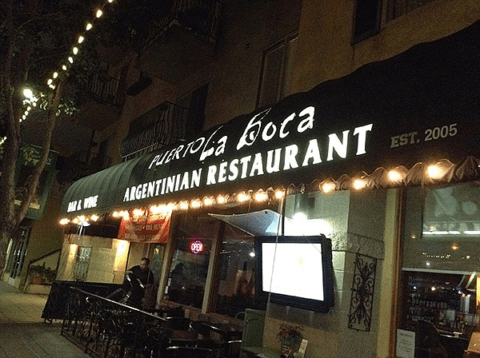
Puerto La Boca serves as a portal to the heart of Argentina’s culinary world, right in the midst of San Diego. This restaurant prides itself on its diverse range of Argentine offerings, from the classic parrillada to the ever-popular milanesas. Patrons often express their delight in customer reviews, emphasizing their favorite dishes and the warm, inviting ambiance that reminds them of the charming eateries in Buenos Aires itself.
8690 Aero Dr #105, San Diego, CA 92123
Pampas Argentine Grill is where the essence of the Argentine pampas is brought to life in San Diego’s dining scene. The grill’s menu is a homage to the traditional flavors of Argentina, offering a variety of meats grilled to perfection and served with authentic sides. Customer experiences often highlight the quality of the asado and the chimichurri’s perfect blend of herbs and spices. Recommendations from diners point to Pampas Argentine Grill as an essential San Diego spot for those seeking to indulge in the true taste of Argentina.
Dallas, a city known for its big skies and bold flavors, also boasts a thriving Argentine culinary scene that adds a South American zest to its Southern charm. Here, the Argentine diaspora has brought along the traditions of their homeland, infusing the local food culture with their rich and hearty flavors.
1807 Ross Ave, Dallas, TX 75201

Corrientes 348 is a proud representation of Argentine gastronomy in the heart of Dallas. The restaurant’s roots are deeply embedded in the traditions of Argentine cooking, offering a menu that ranges from robust steaks to delicate pastries. Guests have consistently given high praise in their reviews, often recommending the restaurant’s signature dishes like the empanadas, the savory mollejas, and the perfectly seared rib-eyes that capture the essence of a true Argentine feast.
3401 W Airport Fwy #112, Irving, TX 75062

Argentina Bakery is a slice of Argentine sweet life, nestled in Dallas. It’s a place where the scents of freshly baked pastries and breads fill the air, reminiscent of a Buenos Aires café. The bakery’s offerings include a variety of traditional Argentine pastries, sandwiches, and desserts. Customer reviews frequently celebrate the facturas, alfajores, and the luscious medialunas as favorites, highlighting the bakery as a top spot for those looking to indulge in authentic Argentine baked goods and confections.
In Phoenix, a city where the sun casts a warm glow nearly year-round, the culinary landscape is peppered with Argentine influences that bring a unique flavor to the Arizona desert. This vibrant city offers a taste of Argentina’s culinary delights, catering to both adventurous foodies and those seeking the comfort of traditional South American dishes.
5651 N 7th St, Phoenix, AZ 85014

While primarily an Italian eatery, Mora Italian stands out in Phoenix for its delightful incorporation of Argentine flavors into its menu, offering a cross-continental fusion that tantalizes the taste buds. Patrons have noted the inventive flair that the restaurant brings to classic dishes, creating a memorable dining experience that merges Italian finesse with Argentine robustness. Signature dishes that have earned customer accolades often include those that blend the best of both worlds, resulting in flavors that are both familiar and excitingly new.
204 E 1st Ave, Mesa, AZ 85210,

Republica Empanada is Phoenix’s go-to destination for a genuine Argentine empanada experience. The restaurant boasts a menu that celebrates the diverse range of Argentine fillings and styles, all served within a warm and welcoming ambiance that’s reminiscent of a cozy eatery in Buenos Aires. Customer reviews frequently commend the restaurant for its wide selection of empanadas, from the classic carne and pollo to more inventive offerings, with many guests highlighting their favorites and the homely, friendly atmosphere that makes every visit a pleasure.
There’s an abundance of options throughout the US, and each one is unique and fantastic in its own right. The simplest starting point is to visit the one closest to you, and then, when the opportunity arises, explore the Argentine culinary delights in other cities. I assure you that each of these restaurants will offer you delectable dishes that transport you on a flavorful journey through Argentina: the smoky char of the grill, the succulence of the meats, the crackling fire, and the rich aromas will create unforgettable dining experiences.
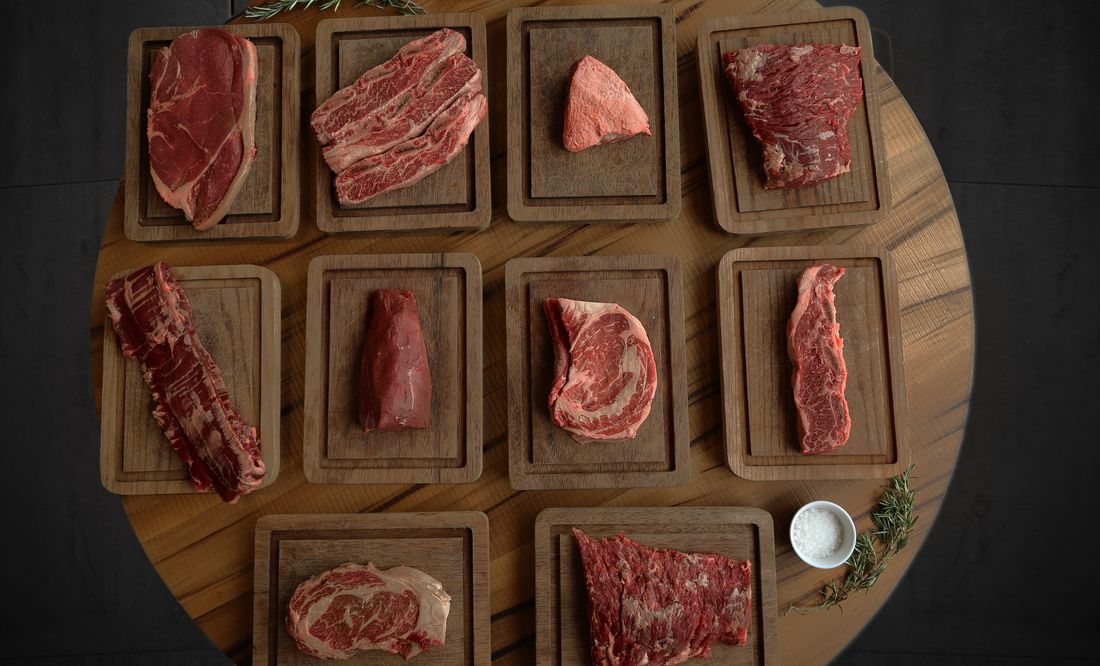
Conveying the full meaning of what an asado to an Argentine means, to others can be a challenge. It’s a ritual that captures the joy of community, characterized by the smoky aroma, the warmth of the fire, and the rich flavors of some of the finest meats you’ll ever taste.
However, before one can master the grill, it’s crucial to understand Argentine beef meat cuts. Each one possesses unique characteristics and flavors, demanding its own cooking approach. Allow me to guide you through an authentic exploration of these meat cuts so you can appreciate them like a true Argentine.
Before we explore the cuts, allow me to share a brief history of meat consumption in Argentina and try to capture the cultural significance it holds within the country.
Argentina’s history is deeply marinated in the tradition of cattle ranching, stretching back to the times when vast pampas were home to roaming herds and gauchos, the legendary cowboys of the South American plains. Beef isn’t just a staple; it’s a symbol of national pride, intricately woven into the fabric of Argentine identity.
It is well-known that Argentina is one of the biggest meat exporters, from June 2020 to May 2021, Argentina exported close to 929 000 tons of beef for a value close to $2.7 million, creating strong business relationships with Europe, the US, and China, among others.
In the heart of Argentina’s culture, beef takes center stage. It’s more than food; it’s a communal experience, a reason to gather, celebrate, and indulge in the craftsmanship of cooking. The ritual of the asado showcases this, where every cut of meat tells a story, every sizzle on the grill is a verse, and every meal is a shared chapter in the grand narrative of Argentine cuisine.
From the succulent bife de chorizo to the lean cuts of lomo, each piece of beef reflects a part of Argentine heritage, savored in homes and restaurants alike, a testament to the land and its history.
In Argentina, the pastoral symphony of the pampas plays host to some of the most revered cattle breeds in the world. The Aberdeen Angus and Hereford stand as the bovine monarchs of these grassy plains, their lineage as much a part of the land as the gauchos who shepherd them.
It’s in the breed and the traditional rearing methods—open ranges, lush pastures, no rush to maturity—that the secret to the beef’s exquisite taste lies. Grass-fed and free-ranging, these cattle live as nature intended, their diet and lifestyle imparting a flavor that’s rich, robust, and unmistakably Argentine. This natural approach to cattle farming is not just a choice; it’s an enduring commitment to quality and sustainability that’s tasted in every tender cut.
Now comes the best part, the one that excites me the most: the beef cuts. Let me tell you about some of the most popular ones and the unique characteristics that make them stand out. Let’s dive in!

The bife de chorizo, a cut that boasts a bold flavor and sumptuous marbling, reigns supreme in the realm of Argentine steaks. This sirloin cut, often confused with the spicy sausage it shares a name with, is a thick, juicy treasure.
For the perfect preparation, grill it over a searing flame to a delectable medium-rare, allowing the fat to render and baste the meat in its own rich, natural flavors.
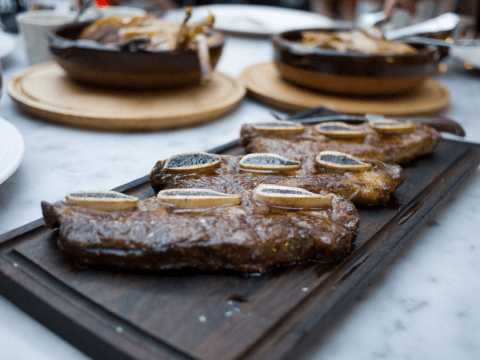
The word ‘asado’ itself is synonymous with Argentine barbecue, and the cut most associated with it is the short ribs. This traditional favorite is best enjoyed cooked slowly over low heat, which allows the meat to become tender and infused with the smoky essence of the grill.
It’s a social cut, meant to be shared, often served with a simple chimichurri that complements its deep, meaty taste.
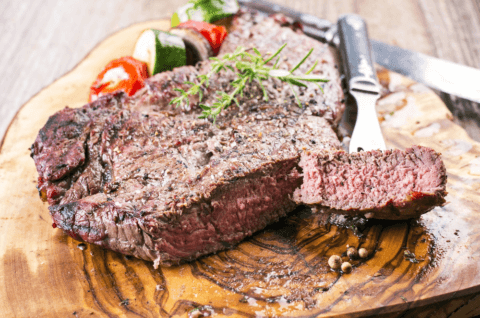
A cut that’s celebrated for its generous marbling and tender texture, ojo de bife is Argentina’s answer to the ribeye. This rich and flavorful steak is often cooked over an open flame to achieve a crusty sear while keeping the inside succulent and slightly pink.
It’s a cut that commands attention on the grill and promises a melt-in-your-mouth experience.
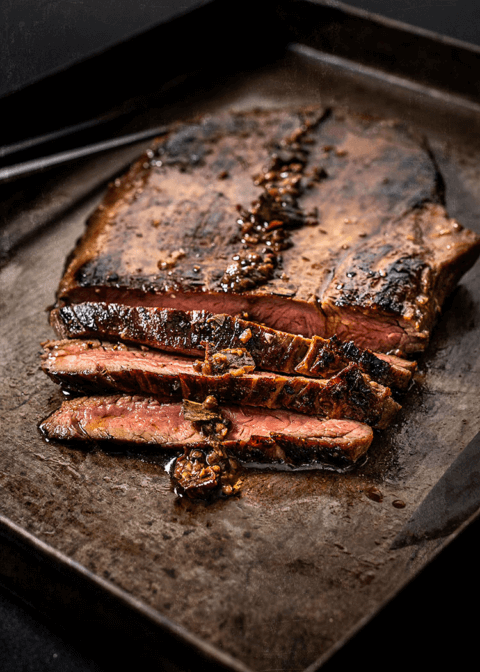
Vacío may not have the international fame of some of its counterparts, but it’s a versatile and beloved cut in Argentina. This flank steak, with its strong beefy flavor and firmer texture, is a favorite for its adaptability.
Whether it’s marinated and grilled to perfection, or slow-cooked and braised, vacío epitomizes the hearty and rustic spirit of Argentine cuisine.
And of course, the variety doesn’t stop with the ones I’ve already introduced to you; there are other, lesser-known cuts that I can promise will offer you different, unique, and delicious flavors and textures.
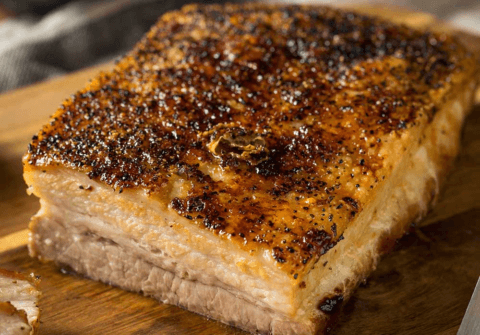
Matambre, thinly sliced from the cow’s flank, is a canvas for culinary creativity. Stuffed with vegetables, herbs, and sometimes boiled eggs, it’s rolled and roasted to create the iconic matambre relleno, a dish as varied as the regions of Argentina itself. Each locale imbues it with local flavors, creating a tapestry of tastes from a single cut.
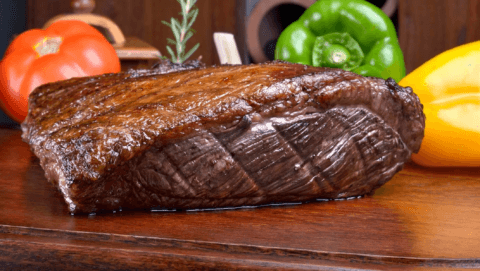
The cuadril, known elsewhere as the top sirloin, is a chameleon in the kitchen. It’s the star in a parrillada, yet it can also be cut into paillard for a quick sear, or even cubed for a hearty stew, showcasing its versatility across a spectrum of Argentine favorites.

The entraña might be lesser known but its robust flavor is legendary among connoisseurs. This skirt steak is prized for its rich, beefy flavor and a texture that soaks up marinades eagerly. Grilled quickly over high heat, it offers a charred exterior and a juicy interior that’s full of character.
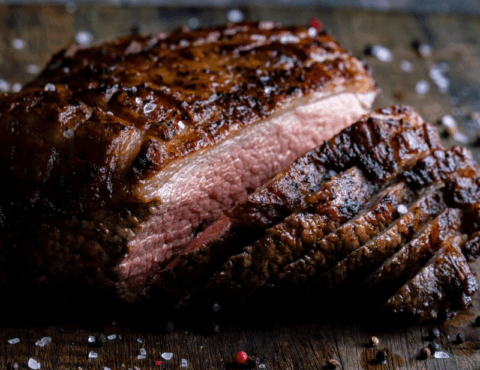
Colita de cuadril may not get the limelight in traditional asado spreads, but its flavor profile is second to none. Often roasted to highlight its tenderness and full-bodied taste, this tri-tip cut embodies the essence of Argentine flavor. It’s a cut that’s patiently waiting for its due recognition on the global stage of beef cuts.
Argentine beef cuts also come in a variety of presentations: a medley of flavors in a Parrillada where chorizo, morcilla, and achuras accompany the beef. There are other dishes like the classic milanesa, showcasing the versatility of beef. So, let’s explore these other beef dishes.
The Parrillada is the epitome of Argentine social dining, a veritable feast of diverse meats grilled to smoky perfection. This culinary showcase extends far beyond the traditional cuts, incorporating a chorus of flavors with chorizo (sausages), morcilla (blood sausage), and succulent mollejas (sweetbreads) mingling alongside cuts like ribeye. Each item on the grill tells a story of taste and tradition, meant to be savored among friends and family, laughter echoing over the crackling coals.
Milanesa a la Napolitana takes the classic breaded and fried beef cutlet to new heights with a topping of ham, cheese, and tomato sauce, baked until bubbling. This dish is versatile, often using cuts like the tender round steak, proving that Argentine beef can be much more than just a steak.
In Bife a Caballo, a juicy steak serves as a bed for a pair of perfectly fried eggs, creating a simple yet satisfying dish. It’s a testament to the Argentine philosophy that when you start with quality beef, you need very little to make it shine.
Churrasco is more than just thinly sliced grilled beef; it’s a celebration of the meat’s natural flavors, requiring little more than a hot grill and a sprinkle of salt. This dish is a staple in Argentine homes, a simple slice of culinary culture that’s enjoyed from the bustling streets of Buenos Aires to the windswept Patagonian south.
Now it’s time to explore the techniques and share some tips that will help you start cooking your own Argentine beef cuts to fully enjoy the authentic asado experience.
Selecting the right cut is akin to choosing the perfect dance partner—it’s all about compatibility. Bife de chorizo’s robustness pairs with the fiery grill, while the delicate matambre is better suited for slow roasting or rolling with fillings. Understanding the texture and fat content is key to matching beef cuts with their ideal culinary destiny.
When selecting your beef cut, consider the desired outcome:
Each cut demands its own cooking technique. The tender ojo de bife revels in the sear of the grill, while the tougher vacío flourishes with slow cooking that breaks down its dense fibers. A cast iron skillet can give a crusty edge to thinner cuts like churrasco, and indirect grilling can coax out the succulence in thicker steaks.
To maximize the potential of each cut:
Argentine beef’s natural flavor is best accentuated with simple seasonings—think sea salt, cracked pepper, and perhaps a brush of chimichurri. Marinades can range from the simple, like a robust Malbec reduction, to the complex, incorporating garlic, herbs, and citric, designed to tenderize and infuse the beef with layers of flavor.
Pair your beef with the right seasonings:
Argentina offers a world-class repertoire of beef cuts, each with its unique flavor and texture, ready to transform your meal into a culinary adventure. From the robust bife de chorizo to the delicate entraña, the quality and diversity of Argentine beef are unrivaled. I invite you to embrace the spirit of Argentine cuisine, to explore the rich array of cuts, and to infuse your cooking with the passion and tradition that make the Argentine experience so unforgettable. Fire up the grill, season generously, and let the journey begin.


The Argentine Malbec Red Wine is among the best in Latin America, and it’s normal to find a bottle on many Argentine tables, ready to be paired with a tasty asado, pizza, or even empanadas. Or even simply for a pleasant time chatting with friends about soccer, economics, and everything in between?
Among all the varieties, there is one in particular I’d like to discuss: Argentine Malbec red wine. Allow me to take you on a journey where I’ll share everything from its brief history to the characteristics that make it unique, all the way to the moment you purchase your first bottle and pop that cork!
Like many other treasures that journeyed to America from the Old World, wine made its way from France to Argentina, in the 19th century with the arrival of French winemakers. Among these was Malbec, a varietal that once found itself overshadowed by its Bordeaux counterparts in its native France. Yet, destiny had a unique path in store for it. Malbec vines traversed the ocean to Argentina, finding a new haven where they would thrive thanks to the right climate and terrain. Particularly in the Mendoza region, they discovered the ideal terroir conditions to not just grow, but to become integral to a burgeoning wine culture that was booming
Today, Argentine Malbec offers a taste of history in every glass. Over the years, this grape has not only adapted to its new Argentine terroir but has also become an integral part of the country’s winemaking identity. From being a blending grape that quietly contributed to Bordeaux’s complexity, Malbec stepped into the spotlight in Argentina, becoming the star of the show.
It’s a story of reinvention and resilience, as Malbec went from near-obscurity in the 1950s to a celebrated jewel in the crown of Argentina’s wine exports. This evolution is a mirror to Argentina’s own growth in the world of wine—a tale of tradition blending with innovation to create something truly extraordinary.
Mendoza is the beating heart of Argentina’s wine country, almost synonymous with Malbec itself. It’s my personal favorite and stands out as the premier region for Argentine Malbec. However, we should not overlook Salta, with its vineyards soaring so high they seem to kiss the heavens, or the Rio Negro, where the Malbec vines are caressed by cool Patagonian breezes.
Each region imparts a distinctive signature to the Malbec it produces, transforming the exploration of Argentine Malbecs from a mere tasting journey into a tour of the country’s soul.
Now comes the best part: guiding you through the tasting notes. Within these characteristics lie the qualities that will captivate you, offering an experience that transcends a mere beverage. This is where you’ll truly celebrate the remarkable influence of the Argentine terroir.
Dive into the flavor profile of Argentine Malbec and you’ll be met with a cascade of dark fruit flavors—think plums, blackberries, and cherries—dancing with hints of chocolate, vanilla, and sometimes a touch of tobacco, thanks to the oak aging process.
The aroma is a heady bouquet of violet and earthy undertones, a fragrance that promises richness and depth.
In texture, a sip of Argentine Malbec is like velvet on the tongue, with a full body that’s robust yet smooth, leading to a finish that lingers, inviting you to take another sip.
When you venture into the world of Argentine Malbec, you’ll find a lineage of wineries that have honed their craft over generations. Here is some examples of famous wineries:

This one is one of the most famous wine producers in Argentina, a pioneering winery that has played a significant role in putting Malbec on the world wine map. Their high-altitude Adrianna Vineyard is famed for producing Malbecs that are nothing short of exquisite.

Based in Salta, home to some of the highest vineyards on the planet, is another producer whose Malbecs are renowned for their intensity and complexity. Then there’s Achaval-Ferrer, whose dedication to expressing the pure character of the grape results in Malbecs that are both powerful and elegant.
As for my personal recommendations, keep an eye out for labels like Malbec Argentino from Catena Zapata, which tells the story of Malbec through its label and liquid artistry. Another must-try is the Finca Altamira from Achaval-Ferrer, a bottle that consistently showcases the heights that Argentine Malbec can reach.
Certainly, enjoying wine extends beyond just sipping it – pairing it with the right food is one of the greatest pleasures. Let me share some pairing recommendations so you can enjoy Argentine Malbec to the fullest, especially with some of the recipes we’ve been chatting about here on the blog

Picture a traditional Argentine asado where Malbec plays a starring role alongside succulent grilled meats. The robust flavors of the Malbec harmonize with the smoky, charred edges of the beef, creating a match that resonates with the soul of Argentine cuisine. For me, this pairing was revelatory; the wine’s notes of blackberry and plum, coupled with a hint of spice, enhanced the savory meat, elevating a simple meal into a memorable dining experience.
But Malbec’s versatility extends beyond Argentine borders. It’s equally at home with the rich sauces and pasta of Italian dining, the bold spices in Mexican mole, or even the complex layers of a Moroccan tagine. The wine’s bright acidity cuts through the richness of these dishes, while its tannins provide a nice counterbalance to the spices and herbs.
Selecting the right Malbec can turn a meal into an occasion. For a dish featuring red meats, a Malbec with a fuller body and higher tannin content can stand up to the robust flavors. If you’re pairing it with something like a spicy lamb curry, look for a Malbec that offers a fruitier profile to temper the heat. For a cheese course, a Malbec that boasts a balance of fruit and oak will complement both soft and hard cheeses alike.
When serving Malbec, take care to pour it at the right temperature, slightly cooler than room temperature, to accentuate its aromas and structure. Decanting the wine can also introduce more oxygen, softening the tannins and allowing the full range of flavors to unfurl. With each sip, you’ll find that the right Argentine Malbec doesn’t just accompany a dish—it converses with it, enhancing and echoing its flavors, creating a dining experience that is truly greater than the sum of its parts.
Just like other Argentine traditions, Malbec is all about coming together with friends and family to have a good time. It’s about sharing, celebrating, uniting, and embracing life even more fully.
From casual family Asados to sophisticated urban soirées, Malbec is the guest of honor at Argentine gatherings. It’s there during lively conversations over Sunday Asados, where bottles are uncorked and shared as freely as the stories being told. In the hustle of Buenos Aires cafés, friends meet over glasses of Malbec to catch up after a long day, and in the quiet of the countryside, a glass of Malbec accompanies the contemplative moments of solitude, reflecting the deep hues of the setting sun.
Malbec is more than a beverage; it’s a companion to the Argentine spirit. Its presence at celebrations—be it a wedding, anniversary, or national holiday—is almost as essential as the event itself. It represents a democratic pleasure, accessible to all and sundry, embodying the nation’s warm hospitality and zest for life.
When it comes to bringing home a piece of Argentina’s soul in the form of Malbec, there’s an art to selecting and storing this beloved wine.
Choosing the right bottle of Malbec can be as rewarding as tasting it. Here, I’ll share my top tips for selecting the perfect bottle to bring home with you:
Once you’ve chosen your Malbec, storing it correctly is crucial to preserve its character. Keep bottles in a cool, dark place where the temperature is consistent, ideally between 12°C and 18°C (53°F to 64°F). Humidity should be moderate to maintain the cork’s integrity, and bottles should ideally be stored on their sides to keep the cork moist, preventing it from drying out and letting air spoil the wine.
Most Argentine Malbecs are ready to be enjoyed young, but they also have the structure to age gracefully. Many can develop more complex flavors over time when stored properly. Entry-level Malbecs are best consumed within a few years of their vintage, while higher-end Malbecs can often benefit from five to ten years of aging, or even longer for premium bottles. Keep in mind, though, that not all Malbecs are made for long-term aging; when in doubt, consult with a wine expert or the winery for their recommendation on the aging potential of your specific bottle.
With the right selection and storage, each bottle of Argentine Malbec you buy can be a future promise of a delightful experience.

I’m thrilled to have taken you on this journey through one of my favorite wines, a beverage that captures the joyous and welcoming spirit of the Argentine people. Consider this an invitation to discover the delightful flavors of Argentine Malbec and immerse yourself in a unique experience. Savor it on your own, share it with friends and family, and pair it with some asado. Let’s raise a glass to life together!
 What's in it for You Every Month on Saturday?
What's in it for You Every Month on Saturday? Special Bonus: Sign up now and get a FREE guide: "5 Secrets to Perfect Asado Every Time"
Special Bonus: Sign up now and get a FREE guide: "5 Secrets to Perfect Asado Every Time"